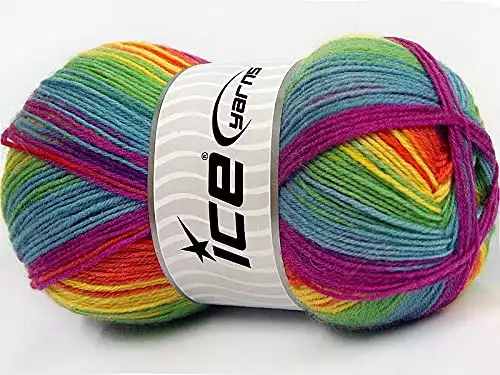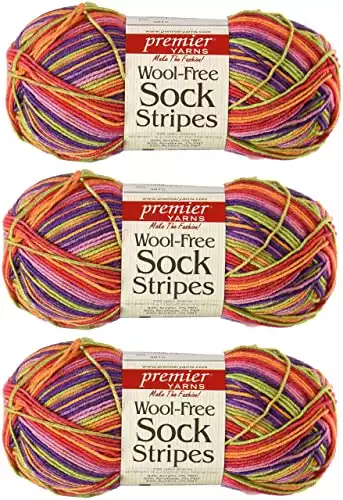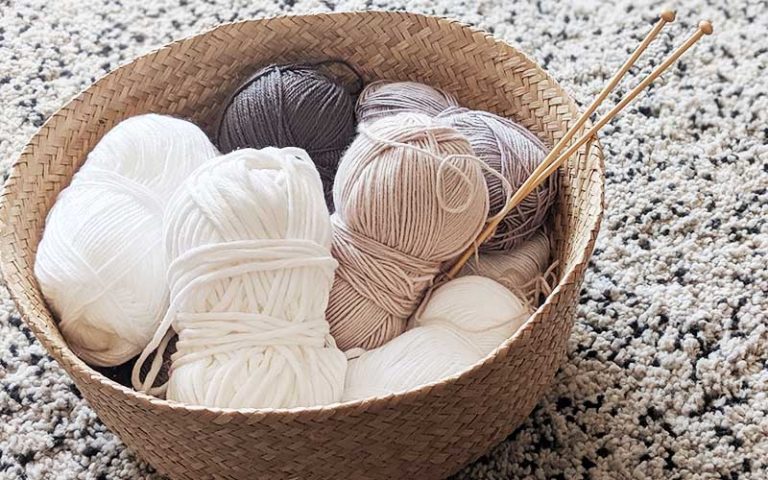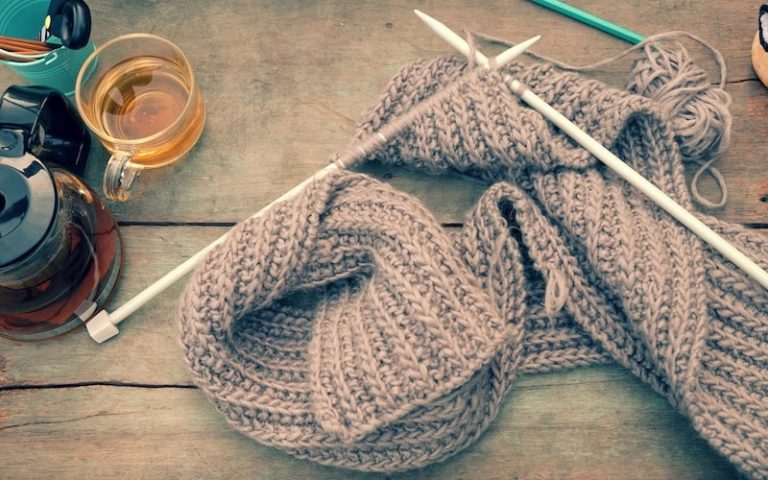Socks are often one of the first items that beginners tackle, and remain a favorite project for more experienced knitters. To knit the perfect pair of socks, you’ll need the perfect yarn.
Best sock yarns for knitting
There is a rather dizzying range of options when it comes to sock yarn, so we’ve put together a list of the best yarns for knitting socks.
1. Smart Rainbow Pattern Sock Yarn
This sock yarn is made from a wool/nylon blend, giving it the advantages of wool with the strength and durability of nylon. It is a blend of 75% wool and 25% nylon.
It has a rainbow variegated color pattern that will look stunning in a plain stitch pattern. The yarn is also superwash, meaning you’ll be able to wash your socks in the washing machine.
2. Patons Kroy Sock Yarn – Amethyst
This is another durable wool/nylon blend, with 75% wool and 25% nylon. The yarn is superfine or fingering weight, so will produce a nice, tight knit.
We like the subtle variegated color pattern of this yarn, which runs from dusky pink to dark purple. This will produce interesting striped socks without having to switch between different yarn colors.
3. Sugar Bush Itty-Bitty Sock Yarn
This superwash yarn is a soft yet strong blend of merino, cashmere, and nylon. The yarn is superfine or fingering weight and the set of two skeins will be enough to make one pair of adult socks.
We like the buttercream shade for a versatile pair of socks, but the yarn is also available in other colors, from bold solid shades to variegated tones.
4. Patons Kroy Sock Yarn – Woodsie
This superfine yarn is another wool/nylon blend that is fully machine-washable. The variegated colors are in natural, woodland shades of greens and browns that would make the perfect pair of cozy winter socks.
The yarn comes in a pack of two skeins that should be sufficient to make a pair of adult socks. You don’t need to worry about mismatching socks as both skeins come from the same dye lot.
5. Living Dreams Galilea Sock Yarn
The 80% superwash merino and 20% nylon blend produces a yarn that is very soft yet strong, a great combination for socks! The fibers are made even stronger by using eight plies instead of the usual three or four.
This colorful yarn comes in a range of variegated tones in virtual every color you can think of. Galilea yarns are also committed to protecting the environment by only using low-impact dyes and vinegar in the dyeing process.
6. Noro Silk Garden Yarn
This yarn is Aran or worsted weight. Although this is significantly heavier than most sock yarns, it is perfect for making chunkier socks for hiking or winter evenings at home.
Noro Silk Garden is a blend of silk, mohair and lambs’ wool, making it super soft and 100% natural. This will produce socks that are extremely comfortable but not as durable as those made from yarn blends that contain nylon.
7. Premier Wool-Free Sock Yarn
If you are allergic to wool or simply don’t like it, then this yarn is the answer! It is a blend of 93% acrylic and 7% PBT, a synthetic fiber that is used for its elasticity.
Along with being comfortable and durable, this yarn is fully machine-washable. It is also a lovely self-patterning variegated mix of purples and greys.
8. Premier Wool-Free Stripes Sock Yarn
Another wool-free option in an explosion of lively, colorful shades, this pack of three skeins feature self-patterning rainbow colors.
The acrylic/PBT blend makes this yarn strong, washable and comfortable with plenty of stretch.
Sock yarn: a buyers’ guide
Sock yarn is one of the most common types of yarn bought by knitters of all levels, so it is important to know what to look for when choosing the perfect sock yarn.
What exactly is sock yarn?
The term ‘sock yarn’ can be used to refer to a specific yarn weight or a yarn that can be used for knitting socks.
As a yarn weight, sock yarn is officially number one on the Craft Yarn Council’s official Standard Yarn Weight System. This type of yarn is ideal for making socks, and hence is generally referred to as ‘sock yarn’.
This category of yarn is also known as fingering or superfine yarn and is one of the lightest weights of yarn on the scale.

This weight of yarn can be used for a range of other projects, not exclusively socks. Sock yarn works well for knitting baby clothes, gloves, shawls, and light, lace-knit garments.
As a more general term, yarn can also be labelled as ‘sock yarn’, meaning that it is suitable for making socks.
This is typically yarn that is either fingering or fine weight (slightly heavier yarn at number two on the scale) and has other characteristics that make it ideal for socks. We’ll take a look at these in the next section.
What makes a good sock yarn?
You could knit a pair of socks with essentially any kind of yarn. However, to knit the perfect pair you need to work with yarn that has certain characteristics.
Some degree of elasticity
For knitting socks, you need yarn that will stretch. Our feet are continually moving and flexing, and so you need a yarn that will move with them.
At the same time, you don’t want your socks to be too loose, and want them to hug your foot and ankle to stay secure. This means that sock yarn should have some elasticity to afford a tight, snug knit that will stretch with your foot.
Strong and durable material
Softer fibers are fantastic for sweaters, scarves and cowls, but they are not so useful when it comes to knitting socks. Socks can get a lot of heavy use and you want them to last, so strength is paramount.
Stronger yarn will last longer without wearing out, and it is also more resistant to pilling. You can be confident that any yarn that is labelled as ‘sock yarn’ will probably be strong enough to withstand heavy use.
If you are not sure if a yarn will be strong enough for a sturdy pair of socks, you can always knit a test swatch and try it out. A good test is to apply some friction to the swatch – for example by carrying it around in your handbag for a few weeks – and see if it starts to look worn.
Absorption
Absorption is another important characteristic of sock yarn. Yarn that is more absorbent will take in moisture and so avoids your feet feeling damp.
Wool is a highly absorbent material: that’s why most sock yarns are either 100% wool or a wool blend. Other natural fibers like cotton also offer a high level of absorption.
Aesthetically appealing
Of course, you want your socks to look nice, so it is important to choose a yarn that is aesthetically appealing. Color is a very personal choice, as is whether you want a solid-color or variegated yarn.
Don’t be afraid to experiment with interesting yarn, but remember that solid colors are best for showing off stitch patterns.
Heavier yarn will result in chunkier socks that are not necessarily aesthetically unappealing, but they certainly have a different look. Therefore, it is important to keep the look you’re going for in mind when choosing yarn weight.
Level of comfort
Obviously, comfort is also an important consideration when choosing sock yarn. You want your socks to be comfortable to wear, but you should also balance this against the need for strength.
Don’t be deterred from using stronger fibers because you think that they are uncomfortable; our feet can handle harsher materials that may feel scratchy on more sensitive parts of the body such as the neck.
Comfort is not just about how the yarn feels against your skin: the weight of the yarn also plays a role. Heavier yarn will make bulky socks that may not fit so well inside your shoes, which is why fine or fingering yarn is usually best.
Is it washable?
It is also important to consider how you will wash your socks. This is a consideration for any garment you knit, but particularly socks, as an item that needs to be washed after every wear.
Many natural fibers are hand wash only. If you want to be able to just throw your socks in the washing machine, look for “superwash” yarn.
On the other hand, there are some ethical concerns in how superwash yarn is produced, so eco-conscious knitters may want to avoid it.
What are the best fiber blends for sock yarn?
The type of fiber you choose to work with makes a big difference in any kind of knitting project, and this is particularly true when it comes to sock yarn. As a functional item, socks need to be able to regulate your temperature and the fiber the yarn is made from will greatly affect this.
100% wool
One of the big advantages of wool is that it is extremely breathable. Therefore, this natural fiber will keep you warm in winter and cool in summer – perfect for socks!
Another advantage of 100% wool is that it is highly elastic, an essential criteria for sock yarn.
It is important to understand the different types of wool:
- Merino is a wool commonly used for fingering yarn due to its softness. However, socks made from 100% merino yarn are prone to felting.
- Mohair wool is elastic, non-itchy and durable, making it a good choice for socks.
- Angora is a soft wool that is very comfortable, but it is also very delicate and so is not a good choice to make socks.
- Alpaca is a strong and comfortable wool that is suitable for socks, but it can stretch out with wear.
However, all wool fibers tend to wear out quicker than synthetic fibers, and this can be problematic with items that get heavy use, such as socks. For this reason, some knitters prefer a knit blend.
Wool/nylon blend
Yarn made from a nylon/wool blend offers many of the advantages of wool, with the extra strength and durability of nylon. This is why nylon/wool blends are commonly used for yarns labelled as sock yarn.
A common and excellent yarn blend is mohair/merino/nylon. This combination delivers an excellent balance of comfort, strength and elasticity.
You can also create your own wool/nylon combination by reinforcing your wool yarn with a fine nylon thread as you knit. You may choose to do this in the sections of the socks that get the most wear, such as the heel and toe sections.
Cotton
Cotton sock yarn is a good choice for light summer socks. This breathable natural fiber will keep your feet cool in summer, though does not offer much warmth on chilly days.
Cotton is highly absorbent, and cotton/nylon blends will help to move the moisture away from the foot, keeping it dry. This makes cotton/nylon yarn great for sports socks.
Cotton is also a good option for people who are allergic to wool. On the downside, 100% cotton socks do tend to stretch out with wear, though this can be avoided by adding nylon or lycra to cotton yarn.
Final thoughts
There is no one-size-fits all approach when it comes to sock yarn. While wool/nylon blends are the most popular choice for knitting socks – and for good reason – individual tastes and preferences mean that this may not be the right choice for you.
Some people prefer completely natural blends such as 100% wool or wool/silk/cotton blends. Others have an intolerance for wool and so should consider wool-free acrylic yarn.
As always, trying out different types of yarn with a test swatch or even a few pairs of socks is the best way to figure out what suits you best. This may take some trial and error, but knitting socks is an excellent way to practice your skills and have fun at the same time!
Go ahead and share this article with your networks so they can find the perfect sock yarn too!



















